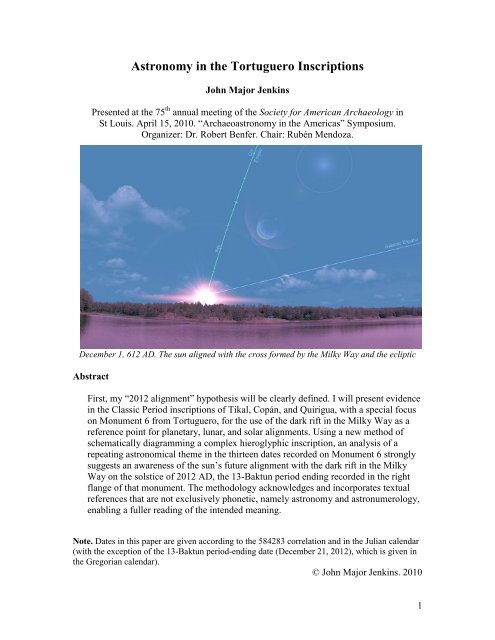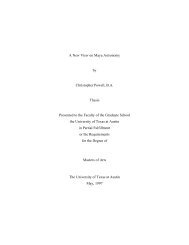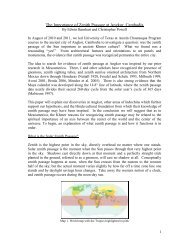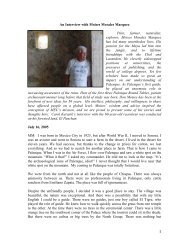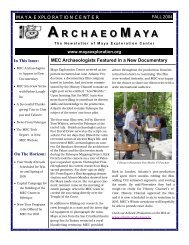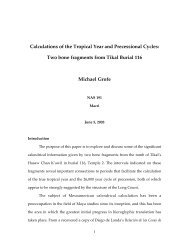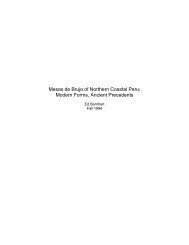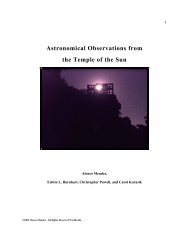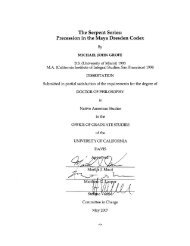Astronomy in the Tortuguero Inscriptions - Maya Exploration Center
Astronomy in the Tortuguero Inscriptions - Maya Exploration Center
Astronomy in the Tortuguero Inscriptions - Maya Exploration Center
Create successful ePaper yourself
Turn your PDF publications into a flip-book with our unique Google optimized e-Paper software.
<strong>Astronomy</strong> <strong>in</strong> <strong>the</strong> <strong>Tortuguero</strong> <strong>Inscriptions</strong>John Major Jenk<strong>in</strong>sPresented at <strong>the</strong> 75 th annual meet<strong>in</strong>g of <strong>the</strong> Society for American Archaeology <strong>in</strong>St Louis. April 15, 2010. ―Archaeoastronomy <strong>in</strong> <strong>the</strong> Americas‖ Symposium.Organizer: Dr. Robert Benfer. Chair: Rubén Mendoza.December 1, 612 AD. The sun aligned with <strong>the</strong> cross formed by <strong>the</strong> Milky Way and <strong>the</strong> eclipticAbstractFirst, my ―2012 alignment‖ hypo<strong>the</strong>sis will be clearly def<strong>in</strong>ed. I will present evidence<strong>in</strong> <strong>the</strong> Classic Period <strong>in</strong>scriptions of Tikal, Copán, and Quirigua, with a special focuson Monument 6 from <strong>Tortuguero</strong>, for <strong>the</strong> use of <strong>the</strong> dark rift <strong>in</strong> <strong>the</strong> Milky Way as areference po<strong>in</strong>t for planetary, lunar, and solar alignments. Us<strong>in</strong>g a new method ofschematically diagramm<strong>in</strong>g a complex hieroglyphic <strong>in</strong>scription, an analysis of arepeat<strong>in</strong>g astronomical <strong>the</strong>me <strong>in</strong> <strong>the</strong> thirteen dates recorded on Monument 6 stronglysuggests an awareness of <strong>the</strong> sun’s future alignment with <strong>the</strong> dark rift <strong>in</strong> <strong>the</strong> MilkyWay on <strong>the</strong> solstice of 2012 AD, <strong>the</strong> 13-Baktun period end<strong>in</strong>g recorded <strong>in</strong> <strong>the</strong> rightflange of that monument. The methodology acknowledges and <strong>in</strong>corporates textualreferences that are not exclusively phonetic, namely astronomy and astronumerology,enabl<strong>in</strong>g a fuller read<strong>in</strong>g of <strong>the</strong> <strong>in</strong>tended mean<strong>in</strong>g.Note. Dates <strong>in</strong> this paper are given accord<strong>in</strong>g to <strong>the</strong> 584283 correlation and <strong>in</strong> <strong>the</strong> Julian calendar(with <strong>the</strong> exception of <strong>the</strong> 13-Baktun period-end<strong>in</strong>g date (December 21, 2012), which is given <strong>in</strong><strong>the</strong> Gregorian calendar).© John Major Jenk<strong>in</strong>s. 20101
<strong>Astronomy</strong> <strong>in</strong> <strong>the</strong> <strong>Tortuguero</strong> <strong>Inscriptions</strong>John Major Jenk<strong>in</strong>sPart I. <strong>Maya</strong> Conceptualization of <strong>the</strong> Dark Rift <strong>in</strong> <strong>the</strong> Milky WayIn this brief presentation I will cite evidence for a simple idea that has far reach<strong>in</strong>gimplications. It is this: An astronomical feature called <strong>the</strong> dark rift <strong>in</strong> <strong>the</strong> Milky Way, or<strong>the</strong> Great Cleft, was recognized and utilized <strong>in</strong> Classic Period <strong>in</strong>scriptions. My previousresearch argues that <strong>the</strong> dark rift was utilized <strong>in</strong> pre-Classic iconography.The dark rift <strong>in</strong> <strong>the</strong> Milky Way is visible to <strong>the</strong> naked eye. It is caused by <strong>the</strong> thickaccumulation of <strong>in</strong>terstellar dust along <strong>the</strong> galaxy’s mid-plane. It beg<strong>in</strong>s at <strong>the</strong> eclipticbetween <strong>the</strong> constellations of Sagittarius and Scorpio and extends northward along <strong>the</strong>Milky Way.Diagram 1. The dark rift and <strong>the</strong> nuclear bulge of <strong>the</strong> Galactic <strong>Center</strong> at <strong>the</strong> Crossroads of <strong>the</strong>Milky Way and <strong>the</strong> ecliptic: perceivable to <strong>the</strong> naked eye.Accord<strong>in</strong>g to <strong>Maya</strong> scholar Barbara Tedlock, <strong>the</strong> contemporary <strong>Maya</strong> <strong>in</strong> highlandGuatemala refer to it as xibal be or xibalba be, <strong>the</strong> ―road to <strong>the</strong> underworld‖ (1982:181).Dennis Tedlock has also identified, <strong>in</strong> his recent book 2000 Years of <strong>Maya</strong>n Literature,<strong>the</strong> various roles of <strong>the</strong> dark rift <strong>in</strong> <strong>the</strong> Dresden Codex, <strong>the</strong> Madrid Codex, <strong>the</strong> ParisCodex, and <strong>in</strong> <strong>the</strong> Creation Myth <strong>in</strong>scriptions of Palenque and Quirigua. For example, a2
deity utilized <strong>in</strong> <strong>the</strong> almanacs of <strong>the</strong> Dresden Codex is named ―Tz’up’e,‖ mean<strong>in</strong>g ―SplitDown <strong>the</strong> Middle,‖ and Tedlock argues that he is placed at <strong>the</strong> dark rift, which splits <strong>the</strong>Milky Way down <strong>the</strong> middle.
In my early approach to <strong>the</strong> 2012 question I was led to exam<strong>in</strong>e <strong>the</strong> pre-Classic site ofIzapa for <strong>the</strong> orig<strong>in</strong>s of <strong>the</strong> Long Count system. The Brigham Young University studiesof Izapa by Gareth Lowe and Garth Norman 4 provided maps and azimuth data, such that Iwas able to extrapolate that <strong>the</strong> ballcourt at Izapa aligns with sunrise on <strong>the</strong> Decembersolstice. I traveled to Izapa and observed <strong>the</strong> solstice sunrise and took measurements toconfirm <strong>the</strong> alignment. 5Diagram 4. The ballcourt at Izapa is aligned to sunrise on <strong>the</strong> December solstice. (The throne on<strong>the</strong> west end and <strong>the</strong> six seat<strong>in</strong>g stones beh<strong>in</strong>d it orient <strong>the</strong> viewpo<strong>in</strong>t)When I was do<strong>in</strong>g my research <strong>in</strong> <strong>the</strong> 1990s I was unaware of <strong>Tortuguero</strong> Monument 6,which conta<strong>in</strong>s a specific date reference to <strong>the</strong> end of <strong>the</strong> current 13-Baktun period <strong>in</strong>2012. 6 S<strong>in</strong>ce I believed <strong>the</strong>re were no Classic Period <strong>in</strong>scriptions that referred directly to<strong>the</strong> 2012 period end<strong>in</strong>g, I based my <strong>in</strong>vestigation on <strong>the</strong> iconography andarchaeoastronomy at Izapa. Now <strong>the</strong>re is an opportunity and a need to analyze <strong>the</strong><strong>in</strong>scription on <strong>Tortuguero</strong> Monument 6, and see what it may tell us about how <strong>the</strong> 2012date was be<strong>in</strong>g utilized <strong>in</strong> a 7 th -century hieroglyphic text.Part II. <strong>Tortuguero</strong> Monument 6<strong>Tortuguero</strong> Monument 6 is a T-shaped stone carv<strong>in</strong>g orig<strong>in</strong>ally consist<strong>in</strong>g of some 176glyph-blocks. The right flange conta<strong>in</strong>s two dates, one of which is 4 Ahau 3 Kank<strong>in</strong>, also<strong>in</strong>dicated with a 13-pik designation (mean<strong>in</strong>g <strong>the</strong> end of <strong>the</strong> 13 th Baktun period). The4
tzolk<strong>in</strong>-haab comb<strong>in</strong>ation of 4 Ahau 3 Kank<strong>in</strong> places this date at December 21, 2012accord<strong>in</strong>g to <strong>the</strong> 584283 correlation.Diagram 5. Left and right flanges and central <strong>in</strong>scription of <strong>Tortuguero</strong> Monument 6, mak<strong>in</strong>g 176total glyph blocks. L<strong>in</strong>e draw<strong>in</strong>g adapted from Gronemeyer (2004).The o<strong>the</strong>r date <strong>in</strong> <strong>the</strong> right flange is December 5, 510 AD (Julian). On this date a sweatbath ritual was performed by a person named Ahkal K’uk. The left flange is miss<strong>in</strong>g andwas never documented. The ma<strong>in</strong> body of <strong>the</strong> text <strong>in</strong> <strong>the</strong> large central panel beg<strong>in</strong>s with astatement about Bahlam Ajaw as <strong>the</strong> Lord of <strong>Tortuguero</strong> and a Distance Numberresult<strong>in</strong>g <strong>in</strong> <strong>the</strong> accession date of Bahlam Ajaw. He was a seventh-century k<strong>in</strong>g of<strong>Tortuguero</strong> and a contemporary of Janaab’ Pakal at nearby Palenque. 7Bahlam Ajaw’s accession is stated as occurr<strong>in</strong>g on February 4, 644 AD (J). SvenGronemeyer first suggested that <strong>the</strong> Distance Number preced<strong>in</strong>g this date can besubtracted from <strong>the</strong> date to reach an earlier date that would have been recorded <strong>in</strong> <strong>the</strong>miss<strong>in</strong>g left flange of <strong>the</strong> monument—his birth date. 8 Michael Grofe noted that anambiguity <strong>in</strong> <strong>the</strong> day position of <strong>the</strong> Distance Number allows a 10-day range of possibledates for his birth, November 23 to December 3 of 612 AD. 95
The T-shape of <strong>the</strong> monument is a structural statement <strong>in</strong> and of itself, mean<strong>in</strong>g w<strong>in</strong>d, orperhaps breath or life-spirit. <strong>Tortuguero</strong> Monument 6 is clearly about <strong>the</strong> life and royalcareer of Bahlam Ajaw, chronicl<strong>in</strong>g his war achievements <strong>in</strong> expand<strong>in</strong>g and transform<strong>in</strong>ghis k<strong>in</strong>gdom while relat<strong>in</strong>g him to distant calendrical events <strong>in</strong> both historical andmythological time. The <strong>in</strong>scription br<strong>in</strong>gs his life up to 669 AD, when <strong>the</strong> monumentwas carved and <strong>the</strong> temple it was placed <strong>in</strong> was dedicated.With Bahlam Ajaw’s birth date reconstructed, <strong>Tortuguero</strong> Monument 6 conta<strong>in</strong>s a total of13 dates. In order to understand <strong>the</strong> astronomical patterns of <strong>the</strong>se dates, we canrecognize <strong>the</strong> structural frame provided by <strong>the</strong> left and right flange.Diagram 6. The tzolk<strong>in</strong>-haab locations of <strong>the</strong> 13 dates on <strong>Tortuguero</strong> Monument 6.6
These two sections literally bracket <strong>the</strong> ma<strong>in</strong> text. The first date, putatively located at <strong>the</strong>end of <strong>the</strong> left flange, is Bahlam Ajaw’s birthday. The last date, <strong>in</strong> <strong>the</strong> analogous positionon <strong>the</strong> right flange, is <strong>the</strong> 13-Baktun period end<strong>in</strong>g <strong>in</strong> 2012. In an email communicationof early 2009, and <strong>in</strong> his paper <strong>in</strong>vestigat<strong>in</strong>g <strong>the</strong> astronomy of <strong>Tortuguero</strong> Monument 6,Michael Grofe noted that, astronomically, <strong>the</strong>re is a parallel between <strong>the</strong>se two dates. 10On both dates <strong>the</strong> sun was <strong>in</strong> alignment with <strong>the</strong> sou<strong>the</strong>rn term<strong>in</strong>us of <strong>the</strong> dark rift <strong>in</strong> <strong>the</strong>Milky Way, between Sagittarius and Scorpio. Bahlam’s birthday, as mentioned, conta<strong>in</strong>sa 10-day ambiguity, but even with<strong>in</strong> this range <strong>the</strong> sun was still reasonably with<strong>in</strong> <strong>the</strong>visual parameters abutt<strong>in</strong>g <strong>the</strong> sou<strong>the</strong>rn term<strong>in</strong>us of <strong>the</strong> dark rift. Fur<strong>the</strong>rmore, I notedthat on both dates Jupiter was at station near <strong>the</strong> Pleiades, about to move direct. Jupiter, itturns out, plays an important role <strong>in</strong> <strong>the</strong> astronomical patterns evident on Monument 6.Curiously, <strong>the</strong> o<strong>the</strong>r date on <strong>the</strong> right flange (December 5, 510 AD) is also a date onwhich <strong>the</strong> sun was aligned with <strong>the</strong> dark rift. 11 The event recorded <strong>in</strong> <strong>the</strong> <strong>in</strong>scription forthis date was a sweat bath rite. Sweat baths were seen to be underworld places. Uponemerg<strong>in</strong>g from <strong>the</strong> sweat bath a person was considered to be emerg<strong>in</strong>g from <strong>the</strong>underworld, much like a rebirth experience. The doorway of <strong>the</strong> sweat bath was thus aportal <strong>in</strong>to <strong>the</strong> watery underworld. The <strong>in</strong>scriptional content is thus re<strong>in</strong>forced by <strong>the</strong>astronomy. In o<strong>the</strong>r words, <strong>the</strong> astronomy associated with dated <strong>in</strong>scriptions can helpelucidate an often miss<strong>in</strong>g dimension <strong>in</strong> <strong>the</strong> purely phonetic decipherment of texts.The performer of <strong>the</strong> sweat bath rite was a person, probably an ancestor or lord, namedAhkal K’uk <strong>in</strong> <strong>the</strong> text. A k<strong>in</strong>g named Ahkal Mo’ Naab ruled Palenque from 501 to hisdeath <strong>in</strong> 524. 12 Gronemeyer (2004) wrote that it is probable that <strong>Tortuguero</strong> was foundedby an early Palenque k<strong>in</strong>g (<strong>the</strong> two sites share a place name), and thus <strong>the</strong>se two may be<strong>the</strong> same person. The sweat bath rite at <strong>Tortuguero</strong> occurred dur<strong>in</strong>g Ahkal Mo’ Naab’sreign, <strong>in</strong> 510 AD. It may have been <strong>the</strong> foundational rite that began <strong>the</strong> dynasty at<strong>Tortuguero</strong>, separate but related to Palenque.Curiously, when Ahkal Mo’ Naab acceded to <strong>the</strong> throne <strong>in</strong> 501 AD, Jupiter was alignedwith <strong>the</strong> dark rift. He died <strong>in</strong> 524 AD almost exactly 88 years before Bahlam Ajaw’sbirth. As with <strong>the</strong> <strong>Tortuguero</strong> k<strong>in</strong>g’s birth, Ahkal Mo’ Naab died when <strong>the</strong> sun wasaligned with <strong>the</strong> dark rift. These astronomical parallels may underlie <strong>the</strong> reason whyBahlam Ajaw referenced him on his biographical monument. 13It was of great <strong>in</strong>terest to <strong>Maya</strong> k<strong>in</strong>gs to draw parallels between<strong>the</strong> lives of ancestor-k<strong>in</strong>gs and <strong>the</strong>ir own.The first event after Bahlam Ajaw’s accession is his first warcampaign and victory. It occurred on May 30, 644 (J). Asepigrapher Michael Grofe po<strong>in</strong>ted out, just three days prior tothis victory, <strong>the</strong>re was a lunar eclipse with <strong>the</strong> eclipsed moon’sposition fall<strong>in</strong>g between Sagittarius and Scorpio, <strong>in</strong> alignmentwith <strong>the</strong> dark rift. (The sun was <strong>the</strong>refore opposite <strong>the</strong> dark rifton this date.) Grofe translates <strong>the</strong> associated <strong>in</strong>scription as ―<strong>in</strong><strong>the</strong> caiman.‖ 14Diagram 7. Three days after eclipse, “<strong>in</strong> <strong>the</strong> caiman.” May 30, 6447
In <strong>the</strong> iconography of Izapa, I have argued that <strong>the</strong> celestial caiman is <strong>the</strong> Milky Way and<strong>the</strong> dark rift is its mouth. This observation is supported by David Stuart’s statement thatIzapa Stela 25 was an early version of <strong>the</strong> Starry Deer Crocodile—<strong>the</strong> Milky Way (Stuart2005:72-73).The next war event occurred exactly 360 days (1 Tun) after Bahlam Ajaw’s accession,<strong>in</strong>dicat<strong>in</strong>g a conscious use of numerological and calendrical <strong>in</strong>tervals. O<strong>the</strong>r datesthroughout <strong>the</strong> late 640s <strong>in</strong>clude ano<strong>the</strong>r date of <strong>the</strong> sun’s alignment with <strong>the</strong> dark rift(December 6, 647), this time along with Venus, and Bahlam Ajaw’s f<strong>in</strong>al victory on <strong>the</strong>December solstice of 649 AD. There are at least six dates on <strong>the</strong> monument that targetastronomical alignments with <strong>the</strong> dark rift.Diagram 8. Dates of alignments of sun, eclipse, and Jupiter with <strong>the</strong> dark rift / Crossroads areaThe 2012 date—<strong>the</strong> last of <strong>the</strong> 13 dates—is, as mentioned, a date of <strong>the</strong> sun’s alignmentwith <strong>the</strong> dark rift, but unlike <strong>the</strong> o<strong>the</strong>r dates on which this k<strong>in</strong>d of solar-dark riftalignment occurs, it occurs on <strong>the</strong> solstice. This is what def<strong>in</strong>es <strong>the</strong> 2012 period end<strong>in</strong>g asoccurr<strong>in</strong>g <strong>in</strong> a unique era of precessional alignment. It is l<strong>in</strong>ked with a Distance Numberto <strong>the</strong> build<strong>in</strong>g dedication event of January 11, 669, which <strong>in</strong> turn is l<strong>in</strong>ked with DistanceNumbers to three o<strong>the</strong>r dates: Bahlam Ajaw’s accession, a nearby hotun end<strong>in</strong>g on July23, 667, and <strong>the</strong> sweat bath ceremony of 510 AD previously mentioned. The hotunend<strong>in</strong>g of July 23, 667 is <strong>in</strong>terest<strong>in</strong>g, because although not directly connected to <strong>the</strong> 2012date with a Distance Number, <strong>the</strong> <strong>in</strong>terval between it and <strong>the</strong> 2012 date never<strong>the</strong>less8
embodies several key divisors. The <strong>in</strong>terval between <strong>the</strong> two dates is 491,400 days. This<strong>in</strong>terval is divisible by key numbers <strong>in</strong> <strong>the</strong> recognized astronumerological canon utilizedby <strong>the</strong> <strong>Maya</strong>: 260, 360, 364, 378, and 819. The use here of <strong>the</strong> 819-day count is veryearly and previously unrecognized, preced<strong>in</strong>g its use by <strong>the</strong> son of Pakal at Palenque byover 20 years. Exactly 600 of <strong>the</strong>se 819-day cycles separate <strong>the</strong> 667 date from <strong>the</strong> 2012period-end<strong>in</strong>g date. 15 The 667 hotun end<strong>in</strong>g date is also characterized by Jupiter be<strong>in</strong>g atstation close to alignment with <strong>the</strong> dark rift. As mentioned, Jupiter at station is also acharacteristic of both Bahlam Ajaw’s birthday and <strong>the</strong> 2012 period-end<strong>in</strong>g date. I devisedan efficient way to represent <strong>the</strong> o<strong>the</strong>rwise confus<strong>in</strong>g sequence of Distance Numbers anddates <strong>in</strong> <strong>the</strong> text, and a surpris<strong>in</strong>g symmetry emerges.Diagram 9. Embedded symmetry <strong>in</strong> <strong>the</strong> occurrence of dates generated with negative DistanceNumbers. The 2012 date (Date 13) is connected to eight o<strong>the</strong>r dates via astronomy, a DN, andastronumerology.9
The hotun end<strong>in</strong>g date of July 23, 667 occurs exactly 18 tropical years after ano<strong>the</strong>r daterecorded on Monument 6, <strong>the</strong> third event <strong>in</strong> Bahlam Ahaw’s war campaigns (July 23, 649AD). This and ano<strong>the</strong>r tropical year relation between two dates on <strong>Tortuguero</strong> Monument6 was noticed by Michael Grofe. The span between <strong>the</strong> two latter pair of dates (December5, 510 AD and December 6, 647 AD) is one day more than 137 tropical years. Both aredates on which <strong>the</strong> sun was aligned with <strong>the</strong> dark rift. The latter date is one day forward,suggest<strong>in</strong>g <strong>the</strong> k<strong>in</strong>d of forward adjustment for precession, through <strong>the</strong> centuries, whichwould be necessary <strong>in</strong> order to project <strong>the</strong> sun’s alignment with <strong>the</strong> dark rift on <strong>the</strong>solstice of 2012. Ano<strong>the</strong>r property of <strong>the</strong> <strong>in</strong>terval, noted by Michael Grofe, is that 137tropical years of 365.242 days each equal 139 Tun of 360 days each. These k<strong>in</strong>ds ofobserved relations between precise calculations of <strong>the</strong> tropical year and Tun periodsprovide <strong>the</strong> precedent for calculat<strong>in</strong>g <strong>the</strong> precession of <strong>the</strong> equ<strong>in</strong>oxes. As explicated <strong>in</strong> his2007 PhD dissertation and o<strong>the</strong>r essays, Grofe f<strong>in</strong>ds accurate precession <strong>in</strong>tervals <strong>in</strong> <strong>the</strong>Serpent Series of <strong>the</strong> Dresden Codex, <strong>the</strong> <strong>in</strong>scriptions of Palenque, and elsewhere. 16Let’s recall that Monument 6 is a chronicle and testimony of <strong>the</strong> life of Bahlam Ajaw. Ihave briefly sketched a framework of patterns <strong>in</strong>volv<strong>in</strong>g solar, lunar, and planetaryalignments to <strong>the</strong> dark rift and Jupiter stations. Bahlam Ajaw died on May 19, 679 AD, asrecorded on <strong>the</strong> <strong>Tortuguero</strong> Wooden Box. 17 On this day Jupiter was aligned with <strong>the</strong> darkrift (see Diagram 10). This f<strong>in</strong>al circumstance suggests an <strong>in</strong>tentional tim<strong>in</strong>g of his deathdate, or a manipulation of <strong>the</strong> actual death date to fit <strong>in</strong>to <strong>the</strong> astronomical patternevidently <strong>in</strong>tentionally embedded <strong>in</strong>to <strong>the</strong> 13 dates on <strong>Tortuguero</strong> Monument 6.Part III. Additional EvidenceAdditional evidence for <strong>the</strong> dark rift’s conceptual role dur<strong>in</strong>g <strong>the</strong> Classic Period is found<strong>in</strong> <strong>the</strong> <strong>in</strong>scriptions and iconography of Tikal (Altar 16), Copán (Stela C), and Quirigua,especially <strong>in</strong> <strong>the</strong> use of <strong>the</strong> Long Count date 9.14.0.0.0. 18 This date is November 29, 711AD (Julian) accord<strong>in</strong>g to <strong>the</strong> 584283 correlation. Like many of <strong>the</strong> dates on <strong>Tortuguero</strong>Monument 6, <strong>in</strong>clud<strong>in</strong>g Bahlam Ajaw’s birthdate, <strong>the</strong> date of <strong>the</strong> sweat bath rite, and <strong>the</strong>2012 period-end<strong>in</strong>g date itself, 9.14.0.0.0 is characterized by <strong>the</strong> sun be<strong>in</strong>g positioned at<strong>the</strong> sou<strong>the</strong>rn term<strong>in</strong>us of <strong>the</strong> dark rift (at <strong>the</strong> Crossroads). The associated iconography onCopán Stela C affirms this astronomical alignment as a recognized characteristic of <strong>the</strong>date, and supports my <strong>in</strong>terpretation that <strong>the</strong> dark rift was at times portrayed as <strong>the</strong> mouthof a caiman. This Long Count date also appears on <strong>Tortuguero</strong> Monument 2.Part IV. SummaryThis has been a very brief treatment of a topic that deserves a more detailed presentation.Of <strong>the</strong> 13 dates on <strong>the</strong> Toruguero monument, six <strong>in</strong>volve alignments of <strong>the</strong> sun, Jupiter,and a lunar eclipse with <strong>the</strong> dark rift/Crossroads, with possibly five additional dates ofsignificance to <strong>the</strong> dark rift. Based upon <strong>the</strong> pattern of astronomical references on <strong>the</strong>2012 monument from <strong>Tortuguero</strong>, it’s likely that <strong>the</strong> people of <strong>Tortuguero</strong> <strong>in</strong>tentionallyused an awareness of <strong>the</strong> sun’s future alignment, on a solstice, with <strong>the</strong> dark rift <strong>in</strong> <strong>the</strong>political rhetoric of a 7 th -century k<strong>in</strong>g. Fur<strong>the</strong>rmore, <strong>the</strong> pre-exist<strong>in</strong>g calendrical structureof <strong>the</strong> Long Count, hav<strong>in</strong>g been developed centuries prior to <strong>Tortuguero</strong>, requires that <strong>the</strong>10
knowledge of <strong>the</strong> 2012 alignment of <strong>the</strong> solstice sun and <strong>the</strong> dark rift/Crossroads wasembedded <strong>in</strong>to <strong>the</strong> Long Count at its very <strong>in</strong>ception, over 2,000 years ago.Diagram 10. May 19, 679 AD (J) death date for Bahlam Ajaw. Jupiter rises at <strong>the</strong> Crossroads <strong>in</strong>alignment with <strong>the</strong> dark rift, just after sundown. Death date is from <strong>the</strong> <strong>Tortuguero</strong> Wooden BoxThe evidence presented here argues that <strong>the</strong> dark rift/Crossroads was utilized as areference po<strong>in</strong>t by <strong>the</strong> Classic Period <strong>Maya</strong> <strong>in</strong> a veritable symphony of alignments<strong>in</strong>volv<strong>in</strong>g <strong>the</strong> sun, <strong>the</strong> moon, planets, eclipses, and <strong>the</strong> solstice position of <strong>the</strong> sun.Overall, it appears to be <strong>in</strong>volved <strong>in</strong> rituals and ideation relat<strong>in</strong>g to sacrifice, rebirth,transformation, period end<strong>in</strong>gs, build<strong>in</strong>g dedications, and k<strong>in</strong>g mak<strong>in</strong>g. This ClassicPeriod evidence <strong>in</strong>vites a more serious and factually accurate assessment of my earlierarchaeoastronomical reconstruction work on precession and dark-rift astronomy atIzapa. 19End Notes:1. Examples of various symbolic roles of <strong>the</strong> dark rift: The dark rift is <strong>the</strong> Black Road, itis a mouth because it speaks to <strong>the</strong> Hero Tw<strong>in</strong>s, and it also serves as <strong>the</strong> crook <strong>in</strong> <strong>the</strong>calabash tree where One Hunahpu’s head was hung. These various uses suggest <strong>the</strong> darkrift was <strong>the</strong> astronomical reference po<strong>in</strong>t for a ra<strong>the</strong>r pliant symbolic complex that hasmany mean<strong>in</strong>gs. It is represented <strong>in</strong> Classic <strong>Maya</strong> iconography as a skeletal maw and isvery likely to be <strong>the</strong> astronomical reference po<strong>in</strong>t, at least <strong>in</strong> some <strong>in</strong>stances, of <strong>the</strong>―Black Hole‖ glyph. See B. Tedlock (1982:181), D. Tedlock (1985), and Jenk<strong>in</strong>s (2009).11
2. My previous research also argues that <strong>the</strong> dark rift was utilized <strong>in</strong> an astronomicalalignment caused by <strong>the</strong> precession of <strong>the</strong> equ<strong>in</strong>oxes that occurs <strong>in</strong> <strong>the</strong> era of <strong>the</strong> 13-Baktun period end<strong>in</strong>g <strong>in</strong> 2012 AD (Jenk<strong>in</strong>s 1995, 1998, 2009).3. I have def<strong>in</strong>ed and discussed <strong>in</strong> my books, presentations, and articles, published andonl<strong>in</strong>e, <strong>the</strong> various parameters of <strong>the</strong> alignment, rang<strong>in</strong>g from a reasonable m<strong>in</strong>imum ofthirty-six years upward to five hundred years, depend<strong>in</strong>g on which astronomical featuresare utilized <strong>in</strong> ones def<strong>in</strong>ition. See, e.g., Jenk<strong>in</strong>s, ―The True Alignment Zone‖http://alignment2012.com/truezone.htm. My argument for <strong>in</strong>tention ra<strong>the</strong>r thanco<strong>in</strong>cidence, however, is based on <strong>the</strong> presence of <strong>the</strong> solar-dark-rift alignment concept <strong>in</strong><strong>Maya</strong> traditions (<strong>the</strong> ballgame and <strong>the</strong> Creation Myth), iconography, and <strong>in</strong>scriptions.4. See Gareth Lowe et. al (1982) and Garth Norman (1973, 1976).5. An exam<strong>in</strong>ation of <strong>the</strong> iconography of <strong>the</strong> Izapan monuments, comb<strong>in</strong>ed with <strong>the</strong>irpreserved orientations to important astronomical horizons, provided evidence for my<strong>the</strong>sis, which is best known from my 1998 book <strong>Maya</strong> Cosmogenesis 2012. This bookdocumented details on <strong>the</strong> fact that <strong>the</strong> ball court at Izapa aligns with <strong>the</strong> dawn<strong>in</strong>gDecember solstice sunrise, which was first recognized and published <strong>in</strong> Jenk<strong>in</strong>s (1995).6. L<strong>in</strong>da Schele’s 1982 catalog of <strong>Maya</strong> verbs conta<strong>in</strong>ed a reference to 13.0.0.0.0 on <strong>the</strong><strong>Tortuguero</strong> monument. Assum<strong>in</strong>g that someone knew about this, it was never brought up<strong>in</strong> <strong>the</strong> many debates about 2012 that occurred as long ago as 1996 on <strong>the</strong> Aztlan forum(Foundation for <strong>the</strong> Advancement of Mesoamerican Studies) and later on <strong>in</strong> <strong>the</strong>University of Texas ―Mesoamerica forum‖ onl<strong>in</strong>e. Nor was it mentioned by Scheleherself <strong>in</strong> her 1996 dismissal of <strong>the</strong> relevance of <strong>the</strong> 2012 date to <strong>the</strong> ancient <strong>Maya</strong>. Seehttp://alignment2012.com/app5.htm.7. Bahlam Ajaw lived from 612 AD to 679 AD while Janaab’ Pakal from Palenque livedfrom 603 AD to 683 AD. They were both rulers whose lives touched five Katuns, a rareoccurrence which gave such <strong>Maya</strong> k<strong>in</strong>gs a special legacy and status.8. Also, Erik Boot suggested that <strong>the</strong> entire left flange, conta<strong>in</strong><strong>in</strong>g twenty glyphs <strong>in</strong>parallel construction with <strong>the</strong> right flange, conta<strong>in</strong>ed <strong>the</strong> correct amount of glyph blocksto express a complete Initial and Supplementary Series for Bahlam Ajaw’s birthday.9. Michael Grofe, p.c. February 2009. See his article ―Astronomical References <strong>in</strong><strong>Tortuguero</strong> Monument 6,‖ n.d. This is slightly less than <strong>the</strong> range offered by Gronemeyer(2004). Some of this material was summarized <strong>in</strong> Jenk<strong>in</strong>s 2009 (Chapter 7). The date thatcorresponds to <strong>the</strong> sidereal position of <strong>the</strong> sun on 13.0.0.0.0 is November 30, 612 AD (J),which is <strong>the</strong> tzolk<strong>in</strong> day 1 Ik. I’ve suggested that <strong>the</strong> T-shape of Monument 6 might be aclue that Bahlam Ajaw’s birthday falls on this Ik day, because Ik is a T-shaped glyph.Interest<strong>in</strong>gly, 1 Ik may have been <strong>the</strong> Calendar Round seat<strong>in</strong>g of 0 Pop at <strong>Tortuguero</strong>.10. Grofe, ―Astronomical References <strong>in</strong> <strong>Tortuguero</strong> Monument 6,‖ n.d..12
11. Ibid. See also my forthcom<strong>in</strong>g essays at The <strong>Center</strong> for 2012 Studies(http://<strong>the</strong>centerfor2012studies.com).12. See Mart<strong>in</strong> and Grube (2000) on Ahkal Mo’ Naab at Palenque and his possible role at<strong>Tortuguero</strong>.13. The haab positions of Ahkal Mo’ Naab’s accession and death day are <strong>the</strong> same,suggest<strong>in</strong>g that his death date was <strong>in</strong>tentionally selected or <strong>the</strong> record of it wasmanipulated for political and rhetorical purposes.14. Grofe noticed this eclipse date as well as <strong>the</strong> sun’s position on Bahlam’s birthday(personal communication February 22, 2009).15. This 819-day observation is my own. It is unlikely that this is a co<strong>in</strong>cidence and<strong>the</strong>refore it was most likely an <strong>in</strong>tended connection with 2012, much <strong>in</strong> <strong>the</strong> way that <strong>the</strong>3114 BC date was <strong>in</strong>tentionally connected to o<strong>the</strong>r dates <strong>in</strong> both historical andmythological time. See Jenk<strong>in</strong>s 2011.16. Grofe 2007, and his ―Astronomical References <strong>in</strong> <strong>Tortuguero</strong> Monument 6,‖ n.d.17. Looper 1991.18. As mentioned, <strong>the</strong>se types of dark-rift alignments were recognized and used beyond<strong>Tortuguero</strong>, as argued <strong>in</strong> <strong>the</strong> recent book of Dennis Tedlock and elsewhere. I have notedadditional examples of dark-rift alignments <strong>in</strong> <strong>Maya</strong> <strong>in</strong>scriptions <strong>in</strong> various articles and <strong>in</strong>my recent book The 2012 Story. For example: <strong>the</strong> Long Count date 9.14.0.0.0, occurr<strong>in</strong>gat Tikal, <strong>Tortuguero</strong>, Copán, Calakmul, and elsewhere, is November 29, 711 AD—a datewhen <strong>the</strong> sun was aligned with <strong>the</strong> dark rift/Crossroads (Jenk<strong>in</strong>s 2009:267-268). Thecaiman mouth iconography on Stela C at Copán re<strong>in</strong>forces this astronomy. This isunderscored as an astronomically mean<strong>in</strong>gful precedent when you consider that <strong>the</strong>Copán k<strong>in</strong>g 18 Rabbit’s decapitation, on April 27, 738 AD (J), was a date on whichJupiter was aligned with <strong>the</strong> dark rift (Jenk<strong>in</strong>s 2009:271-273)—exactly as it had been 59years earlier when Bahlam Ajaw died. The <strong>in</strong>scription from Quirigua Stela F states that<strong>the</strong> decapitation ―happened at <strong>the</strong> Black Hole,‖ (Looper 2003:77) which very probablyalludes to <strong>the</strong> dark rift. These are just a few examples.19. Jenk<strong>in</strong>s 1995, 1998, and my Web page: http://www.Update2012.com.Bibliography:Aldana, Gerardo. 2007. The Apo<strong>the</strong>osis of Janaab’ Pakal: Science, History, and Religionat Classic <strong>Maya</strong> Palenque. Boulder, CO: University Press of Colorado.Grofe, Michael John. 2007. The Serpent Series: Precession <strong>in</strong> <strong>the</strong> <strong>Maya</strong> Dresden Codex.PhD dissertation, Davis: University of California, 2007.13
— ―Astronomical References <strong>in</strong> <strong>Tortuguero</strong> Monument 6,‖ n.d.—2009. ―Fruit from <strong>the</strong> Cacao Tree: From <strong>the</strong> Haab’ to Precession.‖ Miami: Institute of<strong>Maya</strong> Studies, newsletter, Vol. 38, issues 5 and 6 (May and June, 2009).Gronemeyer, Sven. 2004. <strong>Tortuguero</strong>, Tabasco, Mexico: History of a Classic <strong>Maya</strong> Siteas Known from its <strong>Inscriptions</strong>. http://www.sven-gronemeyer.deJenk<strong>in</strong>s, John Major. 1995. The <strong>Center</strong> of <strong>Maya</strong>n Time. Boulder, CO: Four Ahau Press.—1998. <strong>Maya</strong> Cosmogenesis 2012. Santa Fe, NM: Bear & Company.—2009. The 2012 Story: The Myths, Fallacies, and Truth Beh<strong>in</strong>d <strong>the</strong> Most Intrigu<strong>in</strong>gDate <strong>in</strong> History. New York: Tarcher / Pengu<strong>in</strong> Books.—2011 (pend<strong>in</strong>g). ―Approach<strong>in</strong>g 2012: Modern Misconceptions vs. Reconstruct<strong>in</strong>gAncient <strong>Maya</strong> Perspectives.‖ In 2012: Decod<strong>in</strong>g <strong>the</strong> Countercultural Apocalypse, ed.,Joseph Gelfer. London: Equ<strong>in</strong>ox Publish<strong>in</strong>g, Ltd.Looper, Mat<strong>the</strong>w. 1991. A Re<strong>in</strong>terpretation of <strong>the</strong> <strong>Tortuguero</strong> Wooden Box. Texas Noteson Precolumbian Art, Writ<strong>in</strong>g, and Culture, no 11. Aust<strong>in</strong>: <strong>Center</strong> for <strong>the</strong> History ofancient American Art and culture. University of Texas.—2003. Lightn<strong>in</strong>g Warrior: <strong>Maya</strong> Art and K<strong>in</strong>gship at Quirigua. Aust<strong>in</strong>: University ofTexas Press.Lowe, Gareth, Thomas A. Lee, Jr., and Eduardo Mart<strong>in</strong>ez Esp<strong>in</strong>oza. 1982. Izapa: AGuide to <strong>the</strong> Ru<strong>in</strong>s and Monuments. Papers of <strong>the</strong> New World ArchaeologicalFoundation, No. 31. Provo, UT: Brigham Young University.Mart<strong>in</strong>, Simon and Nikolai Grube. 2000. Chronicle of <strong>the</strong> <strong>Maya</strong> K<strong>in</strong>gs and Queens:Decipher<strong>in</strong>g <strong>the</strong> Dynasties of <strong>the</strong> Ancient <strong>Maya</strong>. London: Thames & Hudson.Norman, V. Garth. 1973. Izapa Sculpture, Part 1: Album. Papers of <strong>the</strong> New WorldArchaeological Foundation, No. 30. Provo, UT: Brigham Young University.—1976. Izapa Sculpture, Part 2: Text. Papers of <strong>the</strong> New World ArchaeologicalFoundation, No. 30. Provo, UT: Brigham Young University.Schele, L<strong>in</strong>da. 1982. <strong>Maya</strong>n Glyphs, <strong>the</strong> Verbs. Aust<strong>in</strong>: University of Texas Press.Stuart, David. 2005. The <strong>Inscriptions</strong> From Temple XIX At Palenque. San Francisco: ThePre-Columbian Art Research Institute.14
Tedlock, Barbara. 1982. Time and <strong>the</strong> Highland <strong>Maya</strong>. Albuquerque: University of NewMexico Press.Tedlock, Dennis. 1985. The Popol Vuh: The Def<strong>in</strong>itive Edition of <strong>the</strong> <strong>Maya</strong>n Book of <strong>the</strong>Dawn of Life and <strong>the</strong> Glories of Gods and K<strong>in</strong>gs. New York: Simon and Schuster.Revised 1996.—2010. 2000 Years of <strong>Maya</strong>n Literature. Los Angeles, CA: University of CaliforniaPress.Illustrations <strong>in</strong> <strong>the</strong> SAA 2010 Power Po<strong>in</strong>t presentation:Open<strong>in</strong>g slide: The sun’s alignment with <strong>the</strong> dark rift on Bahlam Ajaw’s birthday.1. Layout of galaxy with dark rift feature <strong>in</strong>dicated2. The Dresden Codex deity named Tz’up’e3. The precession-caused galactic alignment process over thousands of years4. Izapa’s ballcourt alignment to <strong>the</strong> December solstice sunrise5. <strong>Tortuguero</strong> Monument 6 w/ close-up of 2012 date (Gronemeyer 2004; revised 2009)6. L<strong>in</strong>e draw<strong>in</strong>g of <strong>Tortuguero</strong> Monument 6 w/ 13 dates highlighted7. Close up of <strong>the</strong> caiman and eclipse glyphs, w/ tzolk<strong>in</strong>/haab date8. Dark rift alignment dates on <strong>Tortuguero</strong> Monument 6 <strong>in</strong>dicated (6 out of 13 dates)9. Depiction of symmetrical relations of <strong>the</strong> 13 dates on <strong>Tortuguero</strong> Monument 610. Jupiter-dark rift alignment on Bahlam Ajaw’s death date, May 19, 679 AD (J)11. Chart 1, simplified, alignment dates highlightedChart 1. Dates, DNs, and <strong>Astronomy</strong> on <strong>Tortuguero</strong> Monument 6 (see next page).Postscript. November 2010. Most of <strong>the</strong> present paper was worked out <strong>in</strong> December 2009.Many of <strong>the</strong> ideas and discoveries presented <strong>in</strong> this paper grew out of conversations with MichaelGrofe immediately after <strong>the</strong> Tulane ―2012‖ conference <strong>in</strong> early February, 2009. It is at that timethat <strong>the</strong> astronomical importance of <strong>Tortuguero</strong> Monument 6 was first realized. The events of <strong>the</strong>Tulane conference are described <strong>in</strong> Chapter 6 of my book The 2012 Story, released <strong>in</strong> October2009. In Chapter 7 of that book, some of <strong>the</strong> astronomical reconstructions of <strong>the</strong> date sequences<strong>in</strong> <strong>Tortuguero</strong> Monument 6 were presented, for <strong>the</strong> first time <strong>in</strong> pr<strong>in</strong>t. Researcher Geoff Straysummarized <strong>the</strong> key items of this work <strong>in</strong> an article which was posted onl<strong>in</strong>e. <strong>Maya</strong> scholarsrevisited <strong>the</strong> Monument 6 <strong>in</strong>scription <strong>in</strong> two subsequent treatments, one be<strong>in</strong>g a self-publishedbook by Mark Van Stone released <strong>in</strong> April 2010 and ano<strong>the</strong>r be<strong>in</strong>g a study by Sven Gronemeyerand Barbara MacLeod, posted as Note #34 on <strong>the</strong> Wayeb website <strong>in</strong> August 2010. These studiesdid not mention or treat <strong>the</strong> astronomical content of <strong>Tortuguero</strong> Monument 6. Columbianresearcher Carlos Barrera Atuesta released an essay <strong>in</strong> September 2010 which was an ―OpenLetter to <strong>Maya</strong>nists‖ explor<strong>in</strong>g calendrical relationships between dates <strong>in</strong> <strong>the</strong> <strong>Tortuguero</strong>Monument 6 <strong>in</strong>scription and <strong>the</strong> Venus Tables <strong>in</strong> <strong>the</strong> Dresden Codex. This suggests <strong>Tortuguero</strong>was an important location for <strong>the</strong> practice of <strong>Maya</strong> astronumerology and Venus track<strong>in</strong>g.The present paper was read at <strong>the</strong> 75 th Society for American Archaeology conference <strong>in</strong> St Louison April 15, 2010. It is a concise treatment of <strong>the</strong> astronomical strategies that underlie BahlamAjaw’s rhetorical statements <strong>in</strong> his <strong>in</strong>scriptions. An expanded version of this material has beenprepared for publication with <strong>the</strong> University of Florida Press.15
Chart 1. Dates, DNs, and <strong>Astronomy</strong> on <strong>Tortuguero</strong> Monument 6All dates are given <strong>in</strong> <strong>the</strong> Julian calendar (J) <strong>in</strong> <strong>the</strong> GMT2 correlation (JD# 584283).DN = Distance number; L.C. = Long Count. (G) = Gregorian. DR = dark rift. MW = Milky Way.Date and event Derived from <strong>Astronomy</strong>1. L.C. Between 9.8.19.9.15 and 9.8.19.10.5(Nov. 23 – Dec. 3, 612 AD (J)).7 Men 3 Kank<strong>in</strong> – 4 Chik’chan 13 Kank<strong>in</strong>Bahlam Ajaw’s birthday = 1 Ik? T-shape.2. L.C. = 9.10.11.3.10 (Feb. 4, 644 AD). 1Ok 3 Kumku. Bahlam Ajaw’s accession.3. L.C. = 9.10.11.9.6 (May 30, 644).13 Kimi 14 Zec. First war event.4. L.C. = 9.10.12.3.10 (Jan. 29, 645).10 Ok 18 Kayab. Second war event.5. L.C. = 9.10.16.13.6 (July 23, 649).8 Kimi 9 Mol. Third war event, Yohm Pi―was chopped.‖6. L.C. = 9.10.17.2.14 (Dec. 18, 649).13 Ix 17 Muan. Big victory over Comalcalco.Skull piles.7. L.C. = 9.10.15.1.11 (Dec. 6, 647).11 Chuen 4 Muan. Unknown event.8. L.C. = 9.10.15.0.0 (Nov. 5, 647).6 Ajaw 13 Mac. Hotun end<strong>in</strong>g.9. L.C. = 8.15.16.0.5 (Feb. 26, 353).11 Chicchan 13 Muan. Event <strong>in</strong> <strong>the</strong> ―Plaza ofBaakil‖ (Palenque?).10. L.C. = 9.11.16.8.18 (Jan. 11, 669).9 Etznab 6 Kayab. Build<strong>in</strong>g dedication event.11. L.C. = 9.11.15.0.0 (July 23, 667).4 Ajaw 13 Mol. Hotun end<strong>in</strong>g. Six housesand images ―laid down.‖12. L.C. = 9.3.16.1.11 (Dec. 5, 510).8 Chuen 9 Mac. Ahku’ul K’uk does sweatbath ritual.13. L.C. = 13.0.0.0.0 (Dec. 8, 2012 (J), Dec.21, 2012 (G)). 4 Ajaw 3 Kank<strong>in</strong>. 13-Baktunperiod end<strong>in</strong>g, Bolon Yokte event.DN 1.11.11.__ at E4-E5 subtracted fromDate 2.Established withtzolk<strong>in</strong>-haab date at F6-E7.DN 5.16 at E9 added toDate 2.DN 12.4 at F12 addedto Date 3.DN 4.9.16 at F15-E16added to Date 4.DN 7.8 at G2 added toDate 5.DN 3.16.1 at H9-G10added to Date 2DN 1.11 at H13 subtractedfrom Date 7.DN 14.19.1.6 at H15-H16 subtracted fromDate 7.DN 1.5.5*.8 at I3-I4added to Date 2.DN 1.8.18 at J8-I9subtracted from Date10.DN 8.0.7.7 at L16-L17subtracted from Date 10Sun <strong>in</strong> DR. Jupiter just reachedSTATION after retrograde period,below and slightly west of <strong>the</strong> Pleiades.Uranus <strong>in</strong> DR. Jupiter & Venusconjunct, east of DR on edge of <strong>the</strong>MW.Sun opposite DR. Lunar eclipse 3 daysearlier, <strong>in</strong> DR (conjunct Uranus).Jupiter goes retrograde a few daysearlier.W<strong>in</strong>ter Solstice. Moon and Mars closeto Pleiades on <strong>the</strong> 19 th . Sun and Uranusconjunct 5 days later.Sun and Venus conjunct <strong>in</strong> DR. Jupiterat STATION, about to go direct.Jupiter STATION. Sun & Mercuryconjunct, Venus nearby, west edge ofMW.Jupiter just turned direct afterSTATION. Jupiter and Uranus (veryclose) and wax<strong>in</strong>g moon conjunct,opposite <strong>the</strong> DR. Even<strong>in</strong>g sky.Theoretical eclipse on Jan. 8, notvisible. Sun will conjunct Jupiter <strong>in</strong> 5days.Jupiter at STATION <strong>in</strong> <strong>the</strong> DR (westside), about to go direct. Seen <strong>in</strong> midheavenat sundown.Sun <strong>in</strong> DR (east side). Mercury ateven<strong>in</strong>g station.DN 3.8.3.9.2 at M5-P1 Sun <strong>in</strong> DR (on <strong>the</strong> solstice). Jupiteradded to Date 10. almost at STATION, after retrogradeperiod, below and just east of <strong>the</strong>Pleiades (compare w/ Date 1).*This appears as ―6‖ <strong>in</strong> <strong>the</strong> text, but is a scribal error; it must be 5 to reach <strong>the</strong> stated tzolk<strong>in</strong>-haab position.Note: ―DR‖ is shorthand for ―dark rift.‖ A measure of specificity can be added to <strong>the</strong> actual locationof a given celestial body’s alignment with <strong>the</strong> dark rift. For example, it is more precise to say that <strong>the</strong>alignments occur with <strong>the</strong> sou<strong>the</strong>rn term<strong>in</strong>us of <strong>the</strong> dark rift. Several are some distance east or west of<strong>the</strong> galactic equator. The po<strong>in</strong>t is to highlight <strong>the</strong> astronomical region <strong>in</strong>volved, which could be saidto embrace <strong>the</strong> Crossroads and, conceptually, <strong>the</strong> larger nuclear bulge of <strong>the</strong> Milky Way’s center.16


